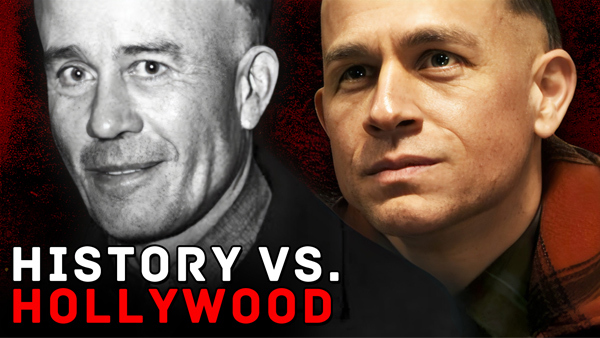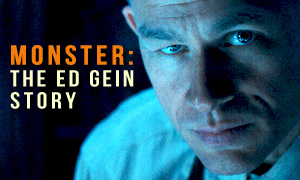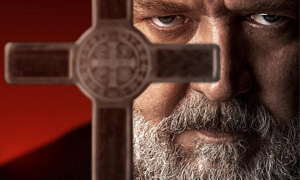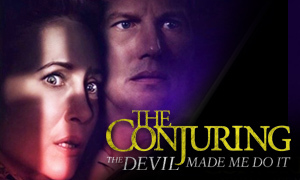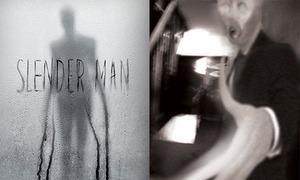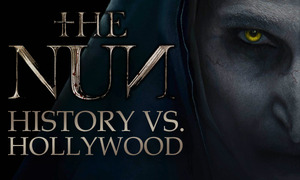How Accurate is "Monster: The Ed Gein Story"? Fact vs. Fiction
Are Ed Gein's conversations with his mother based in reality?
No. Regarding Ed's interactions with his mother, biographer Harold Schechter stated, "Other than the few things Ed said about it in his confessions, we don't really know what went on between them." Schechter said that even in his own book Deviant: The Shocking True Story of Ed Gein, The Original "Psycho", he created imaginative reconstructions to depict what might have gone on between Ed and his mother Augusta. The series creates its own fictional and more exaggerated interpretations of their possible interactions.
Did Ed Gein engage in autoerotic asphyxiation?
No. Ed Gein biographer Harold Schechter told the New York Post that the very first scene of Monster: The Ed Gein Story, in which Charlie Hunnam's character engages in autoerotic asphyxiation, is pure fiction. "I'm like, 'Where did that come from?'" Schechter said. "There's no evidence whatsoever that Ed ever enjoyed that particular activity."
Was Ed Gein ever officially connected to his brother Henry's death?
No. A fact-check reveals that Ed's older brother Henry Gein's official cause of death was asphyxiation during a brush fire on the family's farm in Plainfield, Wisconsin. Ed and Henry had been burning marshland vegetation on May 16, 1944 when the fire spread uncontrollably. According to reports, Ed escaped unharmed but Henry was lost in the blaze. Ed gathered a search party together that included Deputy Sheriff Frank Engle. According to news reports at the time, they discovered his brother's body several hours after the search began lying facedown on scorched ground. The body was unburned and there was soot on Henry's clothes. There were funny bruises on Henry's head and he appeared to have been dead for some time. The medical authority at the scene, which included the county coroner, determined that the cause of death was asphyxiation and no autopsy was performed.
Like in the series, there was little reason at the time to suspect that Ed, who had been seen as a "meek little man," was involved in his brother's death. Suspicions that he may have killed his brother arose years later in 1957 after his arrest for murder. Gein biographer Harold Schechter writes that the brothers' tensions over their domineering mother added to the suspicions of foul play. Ed idolized their mother while Henry criticized her. Fueling this tension was likely the fact that Henry planned to marry, despite their mother's belief that women were wicked and romantic and physical relationships should be avoided.
Henry also owned 40 acres of the family farm, with their mother owning the rest, which could be another possible motive for Ed, as he would then become the sole heir to the property. One theory was that Ed killed Henry and staged the fire to cover it up. This is how Monster: The Ed Gein Story chooses to depict Henry's death, but in doing so it's utilizing creative license. Ed always maintained his innocence.
Did Ed Gein's mother suffer a stroke?
Yes, according to the true story, the paralyzing stroke happened in 1944, the same year as Ed's brother Henry's death. Like in the series, later the following year, Augusta Gein died from a second stroke shortly after berating a woman who had been in the nearby home of a man named Smith. Ed and Augusta had gone to the home to purchase straw, not collect a debt. Smith, who was well known for his short temper, was outside the home beating a puppy and the woman came out onto the porch yelling for him to stop. The man refused and beat the dog to death, but that's not what bothered Augusta the most. Instead, she called the woman "Smith's harlot" since the two were not married. Augusta Gein passed away less than a week later on December 29, 1945 (not immediately after yelling at Smith and the woman). She reportedly died in her home.
Was Ed Gein inspired by Ilse Koch, aka "The Witch of Buchenwald"?
This is speculation on the part of the creators of the Netflix series, as well as Harold Schechter, the author of the Ed Gein biography Deviant. Ilse Koch was the wife of Karl-Otto Koch, commandant of the Buchenwald concentration camp. She had indeed lived luxuriously amid the camp's atrocities, where over 56,000 prisoners died. She was accused of selecting tattooed prisoners for execution to harvest their skin for lampshades, book covers, gloves, and other ghastly creations like shrunken heads.
Ilse's trial was reported on by American news media, but Ed Gein never made any statements about her or that he was influenced by her alleged war crimes. While she was mentioned in pulp magazines and comics, there was never a comic book titled "The Bitch of Buchenwald". In fact, she was more commonly referred to as "The Witch of Buchenwald". The moniker stemmed from her documented cruelty at the camp. However, many of the most lurid accusations against her (like mass production of human-skin items) were later debunked or unproven in her trials.
Ilse Koch is mentioned in Schechter's biography of Gein, in which he depicts Gein reading a pulp magazine that features a story about the atrocities committed by Koch. However, Schechter has stated that while his book does not deviate wildly from the truth like the Netflix series, it is a work of creative non-fiction, meaning Schechter took some liberties to fill in the gaps in what we know about Ed Gein's life.
Did Ed Gein make masks out of human skin?
Yes. The true story behind Netflix's Monster: The Ed Gein Story confirms that he used female skin to make masks and body suits. He believed that by creating a woman skin suit that resembled his mother he could crawl inside and become her. It was a way he could keep her presence with him. He also modified furniture, including a chair and a lampshade, and he used human skulls for food bowls. As indicated in the series, the masks were the inspiration for the skin masks worn by Leatherface in the horror movie The Texas Chainsaw Massacre.
Was Ed Gein a grave robber?
Yes. According to TIME magazine, Gein watched the obituaries to target fresh graves to rob. He exhumed the bodies of "nine or ten" women from three local cemeteries—Plainfield, Spirit Land, and Hancock—taking various body parts and in one instance the entire corpse. It's true that one of the graves he dug up adjoined his mother's.
Did Ed Gein have a girlfriend named Adeline Watkins?
While Adeline Watkins was indeed a real person, her relationship with Ed Gein is grossly exaggerated in the series. The series depiction of the romance is loosely based on Watkins initial claims about her and Gein's relationship after his crimes were discovered on November 16, 1957. She had told the Minneapolis Tribune that she and Gein had dated for over 20 years, calling him "good and kind and sweet." She also claimed that they regularly talked about murders that were in the news. "Eddie told how the murderer did wrong, what mistakes he had made. I thought it was interesting," she said.
Watkins told the paper that Gein had tried to propose to her two years earlier in "not so many words, but I knew what he meant." She said she turned him down and that was the last time they saw each other. Her revelations, which were reprinted in newspapers across the country, particularly shocked the residents of Plainfield, who could not remember ever seeing Gein with a woman.
Roughly two weeks after the story was published, Adeline Watkins changed her tune. In an article that appeared in the Stevens Point Journal, she retracted her claims about being in a 20-year relationship with Ed Gein, calling the earlier newspaper article, "an exaggeration, blown up out of proportion to its importance and containing untrue statements." She said that though she had known Gein for 20 years, her romance with him lasted only seven months and was intermittent. She said that they went to shows at the Plainfield Theater "a few times" and he stopped at her home "on some afternoons or evenings." Watkins said that she never went to his home. She added that prior to his crimes being discovered, "she felt rather sorry for Gein."
Unlike what's seen in Monster: The Ed Gein Story, there was never any evidence that she was his accomplice or ever knew about his crimes. In the final episode of the series, Adeline visits Gein and expresses to him her desire to become a killer, which is also total fiction. The series tries to get away with this by leaving us to wonder if the visit is part of Gein's imagination.
According to Ed Gein biographer Harold Schechter, "Their relationship, I'm pretty convinced, didn't really consist of anything more than possibly maybe Gein once asked her roller skating or something. They didn't really have a relationship. She was kind of a publicity hound. When all the media descended on Plainfield after the discovery of the crimes, she suddenly came forward as Ed Gein's girlfriend." In addition, Schechter told the New York Post that while Adeline Watkins is depicted as a beautiful young woman in the series, the real Adeline Watkins was much older and "bares a striking resemblance to Margaret Hamilton in The Wizard of Oz."
Was Ed Gein a necrophiliac?
Monster: The Ed Gein Story depicts Charlie Hunnam's character partaking in necrophilia with one of the bodies he dug up. However, a fact vs. fiction examination reveals that Gein denied having sexual relations with the bodies. Schechter's Ed Gein biography states, "He denied having sex relations with the bodies or parts of them as he declares the odor was offensive." Similar is stated in a 1957 TIME magazine article, "Gein practiced neither cannibalism nor necrophilia, but preserved the remains just to look at." Schechter writes that Gein denied this "several times" when questioned.
Was Ed Gein linked to the disappearance of babysitter Evelyn Hartley?
No. Evelyn Hartley was indeed a real person who disappeared in October 1953 while babysitting in Wisconsin, but investigators determined that Ed Gein was not involved. In reality, the disappearance happened while 15-year-old Evelyn was babysitting in La Crosse, Wisconsin, which was about two hours away from Gein's farmhouse in Plainfield. Ed Gein had been born in La Crosse and still had relatives there, but he claimed that he hadn't been back since his family moved when he was seven. Gein said that he had been doing some odd jobs for a neighbor on the day of Evelyn Hartley's disappearance.
Evelyn was the daughter of a biology professor and had been babysitting the 20-month-old daughter of her father's colleague, Professor Viggo Rasmussen. Viggo, his wife Madeline, and their older daughter Rozalyn were at the La Crosse State College homecoming football game, a popular event in town. Like in the series, the intruder is believed to have snuck into the Rasmussen home by forcing open a basement window.
The scenes in the series where Gein stalks Evelyn and blames her for being the reason he lost the babysitting job, which culminates with him sneaking into the home and abducting her, are fictional. There's no evidence Gein had any connection to Evelyn at all. After his arrest, he passed a polygraph test regarding her disappearance.
While analyzing the fact vs. fiction, we discovered that the series also fictionalizes the character of Evelyn. The real Evelyn Hartley had not recently recovered from polio. She did have a brother, Richard, who had died from polio three years earlier while serving in the Navy, but there is no record of her having ever had the disease. In the series, she is left with a handicap from the disease in order to up the drama.
The disturbing sequence when Ed Gein murders Hartley with a hammer is also fictional and is meant to echo the hammer scene from Tobe Hooper's 1974 horror movie The Texas Chainsaw Massacre. Series creators Ryan Murphy and Ian Brennan want you to believe that Gein inspired that scene in Hooper's film, but here again they're just making up the connection, as there's no evidence that Gein ever killed anyone in that manner. In real life, Evelyn Hartley's body was never found and the case remains unsolved.
Did Ed Gein ever babysit children?
Yes. According to author Harold Schechter, who wrote the Ed Gein biography Deviant: The Shocking True Story of the Original "Psycho", Ed did babysit local children in the past, but this was back when his mother was still alive and well before he committed the two murders attributed to him. This was also long before he started stealing bodies from the cemetery. Schechter notes that the children were always glad to see Ed. He would tell them creepy stories from the magazines he read and would even do silly magic tricks, but they were far from the macabre magic tricks he performs in the series, which are pure fiction.
Given that Schechter's biography uses speculation at some points to fill in the missing pieces in Ed Gein's true story, it's unclear how accurate these details are in the book. However, the creators of the series have clearly drawn from Schechter's interpretation.
Did Hitchcock cast Anthony Perkins for Psycho because Perkins was a closeted gay man?
No. There is no evidence to suggest that Anthony Perkins' sexual orientation had anything to do with him being cast as Norman Bates in Psycho. In Monster: The Ed Gein Story, Alfred Hitchcock tells Perkins that he chose him for the role because like Ed Gein, Perkins too was confused and deeply troubled. Hitchcock implies that Perkins' crisis around his sexual identity was the driving force behind why he was cast. However, this stems from modern reinterpretations of Psycho, particularly attempts to tie the casting to Norman Bates' complex psychology.
In reality, we know from both interviews and production notes that Hitchcock's decision to cast Perkins stemmed from his focus on Perkins' previous work, not his personal life. Perkins had already gained recognition for his roles in films like 1956's Friendly Persuasion, for which he won a Golden Globe, and 1957's Fear Strikes Out, which showcased his ability to portray complex, sensitive characters. Hitchcock felt that Perkins' boyish looks, nervous energy, and ability to convey psychological depth would be a perfect fit for the character of Norman Bates.
Did Ed Gein engage in cannibalism?
No. As reported by TIME magazine in 1957, Ed Gein claimed that he did not engage in cannibalism and there was no evidence in real life to suggest as much. Furthermore, there were no reports that he ever gave human flesh to neighbors, pretending it was venison, as the show depicts. According to Rolling Stone, cannibalism is also unlikely due to the fact that the majority of the nine women Gein dug up had been embalmed, making it even more unlikely that he would have tried to eat them.
Did Alfred Hitchcock recreate Ed Gein's house and show it to Anthony Perkins as part of Perkins' preparation for Psycho?
No. There's no historical record of Hitchcock recreating Ed Gein's house, including the horrors found within, and showing it to Anthony Perkins as the actor prepared for the role of Norman Bates in Psycho. This is complete fiction. In fact, Psycho was only loosely inspired by Ed Gein's crimes and his obsessive relationship with his mother. The inspiration was indirect through Robert Bloch's 1959 novel of the same name, which Bloch himself said wasn't heavily based on Ed Gein, but rather was a starting point for his novel, which has its own unique narrative.
As most fans of the Alfred Hitchcock movie know, the Psycho house set was an original design inspired by Victorian Gothic architecture. It looks nothing like Ed Gein's farmhouse, which burned down in 1958, prior to the making of Psycho. The Psycho house is still standing on the Universal Studios lot and can be seen during the studio tour.
Were viewers so shocked by the movie Psycho that some left the theater and vomited?
Psycho did create intense audience reactions, but not quite as severe as what's seen in the series. Moviegoers were shocked that Hitchcock would kill off the protagonist (portrayed by Janet Leigh) so early in the film. They were also shocked by the perceived violence of the shower scene, and it's true that there were reports of people walking out or screaming in fright. However, the depiction of people leaving the theater to vomit seems to be a bit of an exaggeration and we found no reports to corroborate such an event.
The more intense reaction to Psycho depicted in the series is due to the fact that it depicts the shower scene as being far more violent than it actually was. Instead of trying to recreate Hitchcock's masterful scene, which famously included no gore (no blood is shown on the body or knife), Monster depicts the scene with both nudity and explicit violence. This is in part due to the scene being blended with one of Ed Gein's schizophrenic episodes. Instead of seeing Janet Leigh's character, we see Gein's girlfriend, Adeline Watkins, as the victim in the shower and Gein as the killer (dressed as his mother).
Did Ed Gein kill two hunters with a chainsaw?
No. In Monster: The Ed Gein Story, two lost hunters stumble upon Gein's farm. They enter the barn and discover Gein and the mutilated body of hardware store owner Bernice Worden. Shocked, they flee the barn and Gein chases after them with a chainsaw. He catches up to them, takes time to put on his human skin mask, and then uses the chainsaw to kill them. He then dances around holding the chainsaw in the air à la Leatherface in The Texas Chainsaw Massacre, the movie his story would loosely inspire.
The problem is that none of this happened. There's no evidence that Gein killed the two hunters, Victor Travis and Raymond Burgess, in November 1952. When questioned about their disappearances after his arrest, he said he was innocent of the murders and even passed a polygraph test. Gein also never murdered anyone with a chainsaw. The series creators are once again retroactively altering Gein's past to bolster his connection to Leatherface, the chainsaw-wielding horror movie villain whose crimes he loosely inspired.
Did Ed Gein really talk like that?
No. While the voice of actor Charlie Hunnam in the series echoes the real Ed Gein's documented softness and mildness, Hunnam exaggerates the childlike affectation in an attempt to create a more impactful character who is constantly yearning for his mother's approval, which some have argued comes off as being over-the-top. Hunnam said that he developed the voice based on his research, which up until the last minute did not include listening to the interrogation tapes of the real Ed Gein, since no one could find them.
"These tapes were just sort of put in a drawer and never released to the world," Hunnam told Radio Times. "I'd heard about them, but nobody could find them. I ultimately did find them, but only about three or four days before we started to shoot. So that voice that I use grew out of my research, and the thing that I couldn't stop thinking about was Ed's burning desire to get the love and affection and acceptance from his mother that he never got. ...
She told him every day for 41 years that she hated him because he'd not been born the daughter that she wanted, so I thought if you don't have any other contact with the outside world, you only have a relationship with one person and that person tells you ever day that she hates you because you're not a girl, what would that do psychologically and emotionally, and how would that manifest in the body? And so I thought this sort of gentle, high-pitched voice might be a way that Ed gave permission to his mother to love him."
Hunnam's voice in the series is somewhat reminiscent of Paul Walter Hauser's voice in the Apple TV+ series Black Bird, in which Hauser portrays serial killer Larry Hall.
Did Ed Gein have a relationship with hardware store owner Bernice Worden?
No. In Monster, Gein is depicted as engaging in a romantic relationship with Bernice Worden. They eat at a diner and then sleep together. However, there's no evidence that they were ever romantically linked in real life. Author Harold Schechter states in Deviant that not long before murdering her, Gein asked her to go roller skating. Though she's depicted as being bawdy and flirtatious in the series, the 58-year-old grandmother was far more conservative in real life. She was a widow and a devout Methodist. As noted by Schechter, she was "held in high regard by most of the community" despite her sharp tongue and at times snippy attitude. She was even the first woman to be honored as Plainfield's Citizen of the Week.
Was Bernice Worden's son a deputy?
Yes. In Netflix's Monster: The Ed Gein Story, actor Charlie Hall portrays Bernice Worden's son, Deputy Frank Worden. He investigates his mother's disappearance and discovers her mutilated body at Gein's residence. This deviates somewhat from the true story. Deputy Frank Worden indeed visited his mother's hardware store and discovered signs of the murder. However, he did not discover a gift box addressed to Gein (they were not romantically involved). Instead, he found a sales receipt for antifreeze made out to Gein from that morning, which was the last transaction his mother had recorded. He also found an open cash register and bloodstains on the floor.
On November 16, 1957, Waushara County Sheriff Arthur Schley and Captain Schoephoerster searched Gein's property and Schley found Bernice's decapitated and mutilated body hanging in a summer kitchen, a shed-like room attached to the rear of the farmhouse. The two men also found plenty of other ghastly evidence. The series depicts Bernice's son Frank Worden as the one who discovers her body, but that's fiction. Frank was not at the scene when his mother's remains were discovered. Though the series shows Frank Worden as later helping to auction off Gein's possessions, he was critical of the auction in real life, saying that it was disrespectful to the victims. Frank and his sister Miriam filed a $57,800 lawsuit against the Gein estate.
Was Ed Gein arrested when he arrived at his home?
No. Monster depicts Gein pulling up to his home after the authorities have discovered his gruesome crimes. In a dramatic scene, he is attacked by Bernice Worden's son, Frank, as he's being arrested. None of this happened in real life. According to reports, Gein was arrested in the driveway of the home of his friend Lester Hill. He had supper with Hill's family not long before his arrest.
Did Ed Gein help solve the Ted Bundy murders?
No. Ed Gein biographer Harold Schechter told the New York Post that the depiction in the series of Ed Gein helping to solve the Ted Bundy murders is "wildly, wildly made up." Essentially, series creators Ryan Murphy and Ian Brennan thought it would be fun to make up a link between Gein and the Netflix series Mindhunter, which is based on real-life FBI agents John Douglas and Robert Ressler and their work for the agency's newly created Behavioral Science Unit in the latter half of the 1970s. The series fictionalizes Douglas and Ressler interviewing Gein about Ted Bundy, but there is no record that the FBI ever talked to Gein.
The scene is also supposed to be a fictional nod to Silence of the Lambs, which finds Jodie Foster's character interviewing the serial killer Hannibal Lecter (Anthony Hopkins) to help catch the killer known as Buffalo Bill.
Was Ed Gein diagnosed with schizophrenia?
Yes. Not long after his arrest, Gein was diagnosed with schizophrenia by court-appointed psychiatrists. He was initially deemed mentally unfit to stand trial. However, he would eventually be tried for the murder of hardware store owner Bernice Worden in November 1968, more than a decade after his arrest.
How many people did Ed Gein kill?
While the series depicts Ed Gein (Charlie Hunnam) committing multiple murders, only two murders have been officially attributed to him. The first is a 54-year-old divorcee tavern owner named Mary Hogan, who he had been friends with, and the second is 58-year-old Bernice Worden, who operated a local hardware store. Gein was eventually only tried for the murder of Bernice Worden and was found guilty of first-degree murder. A subsequent hearing pertaining to Gein's sanity concluded that he was "not guilty by reason of insanity." He was ordered to be committed to Central State Hospital for the Criminally Insane (later renamed Mendota Mental Health Institute).
Though he also admitted to the December 8, 1954 killing of Mary Hogan, he was never tried for her murder for a number of reasons. Unlike Bernice Worden, whose body had been freshly killed, Hogan's older remains were less definitive for building a court case. In addition, Gein's confessions, though detailed, were given under psychological distress not long before he was diagnosed with schizophrenia. Prosecutors also had weaker evidence pertaining to Hogan's murder and were worried trying him on both counts might weaken their case. Having a separate additional trial for Hogan's murder wouldn't have changed the fact that he had already been deemed insane after the first trial and was to be institutionalized for life. As the judge noted, it would have essentially amounted to unnecessary costs. Gein remained institutionalized until his death from lung cancer in 1984 at age 77.
As stated earlier, there was speculation that Gein killed his brother, Henry, but the official cause of death was asphyxiation. As for the other murders in the series, including babysitter Evelyn Hartley and the two hunters, Victor Travis and Raymond Burgess, there was never a link found between those murders and Ed Gein. The police did question him with regard to various missing person cases, but he passed a polygraph test. In fact, the real Ed Gein technically was not a serial killer, which traditionally had been defined as requiring at least three victims, though the FBI updated the formal definition in 2005 to require two or more victims in separate events.
Did Ed Gein inspire future serial killers?
No. As stated above, Ed Gein was not considered to be a serial killer. Not only did he not fit the earlier definition in terms of number of victims, he was also not the type of killer that the term was created to describe.
"He was not a serial killer," biographer Harold Schechter told the New York Post, "because the term serial killer was specifically coined to describe a certain kind of psychopathic sex murderer, an extreme sexual sadist like Ted Bundy or John Wayne Gacy, who derived erotic pleasure from torturing and then killing victims. That was not what Gein was about. He did kill these two women, but he executed them very swiftly. He was basically just interested in bringing their corpses home so he could dissect them. He was not a serial killer and the notion that all these serial killers at the end were inspired by Gein, like Richard Speck, I feel pretty confident that none of them even knew who Gein was. They wouldn't have been inspired by him because he was not a serial killer."
Overall, how accurate is Monster: The Ed Gein Story?
On a scale of 1 to 10 in terms of historical accuracy, with 10 being most accurate, we give Netflix's Monster: The Ed Gein Story a 2 out of 10. In fact, in my 20+ years of researching movies and series based on true stories, Monster is possibly the most fabricated series I've researched. Yes, there are elements from Ed Gein's life in Monster, but each episode is filled with so much fiction that the show hardly resembles the real Ed Gein.
Author Harold Schechter, who wrote what is considered to be the definitive biography of Ed Gein, said that he was never approached by showrunner Ryan Murphy to option his book Deviant. Schechter became worried that there was going to be a lot of unauthorized use of his book in the series. However, his feelings changed after watching it.
Schechter told the New York Post, "There is some unauthorized use of my book, I feel, but the show veers so wildly from the reality of the case, so much of it is pure over-the-top fabrication, that now I'm mostly upset that all the people who watch the show are gonna think they're seeing the true story of Ed Gein." Schechter said that each episode is approximately 90% fabrication.
Schechter noted that the broad outlines of Gein's life are there, including "his relation to his domineering mother, the grave robbery, the making of these ghastly objects out of the body parts, and so on, those are pretty accurate, but a very large percentage of the show is just made up. ... Either Murphy or Ian Brennan who wrote it just invented these outrageous things, which have no relationship to the true facts of the Ed Gein story. ... My jaw dropped at how shameless the whole production was."
And it's not just Gein's life that's heavily fictionalized. As described earlier, the series shamelessly fictionalizes the backstories of movies like Psycho, The Texas Chainsaw Massacre, and The Silence of the Lambs to imply that Ed Gein was more of an inspiration on those films than he actually was. Gein's life is also retroactively fictionalized to strengthen his connection to those films. For example, he never killed anyone with a chainsaw like the character Leatherface does in The Texas Chainsaw Massacre, nor did he then dance around with the chainsaw above his head.
The more the series goes on, the more ridiculous the mounting fabrications become. It's as if creators Ryan Murphy and Ian Brennan just said, "F*** the true story, we'll make up something better," which seems to be Murphy's go-to strategy, for better or worse, obviously for worse in terms of historical accuracy. The result is that much in the same way that Ed Gein loosely inspired movies like Psycho, The Texas Chainsaw Massacre, and The Silence of the Lambs, in the end, he is similarly a loose inspiration for his own "biopic" Monster: The Ed Gein Story.
